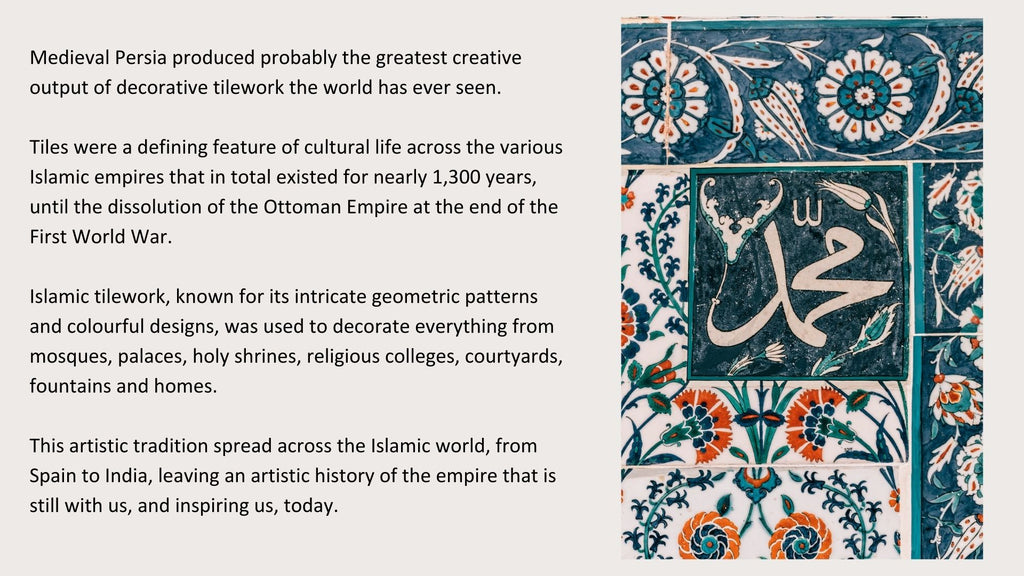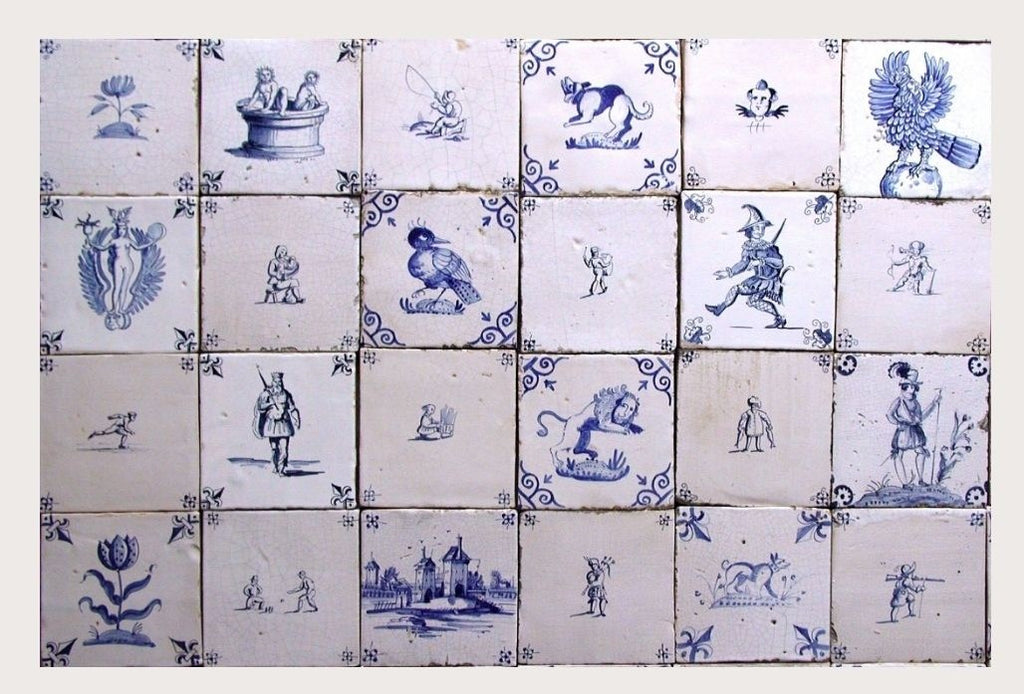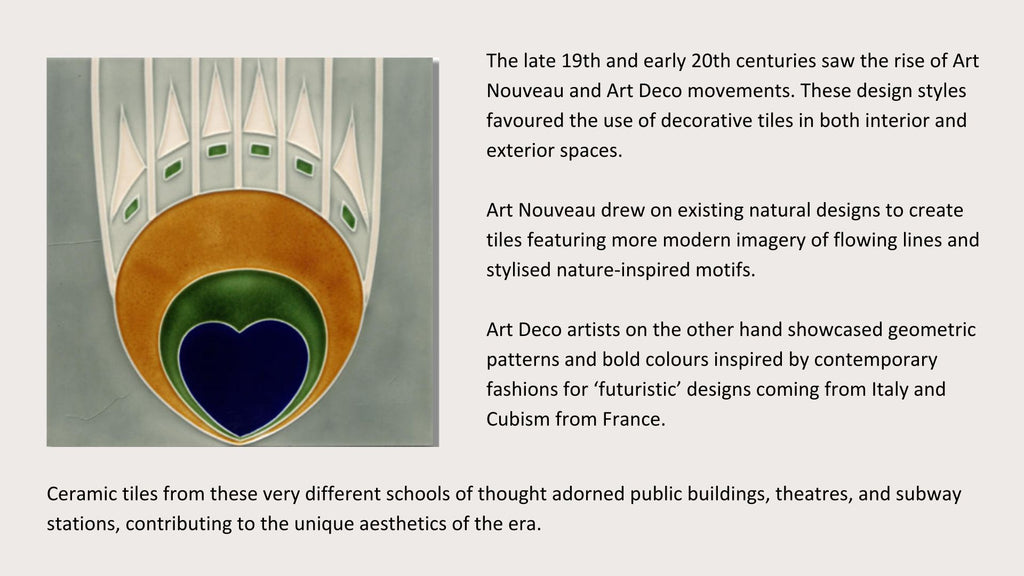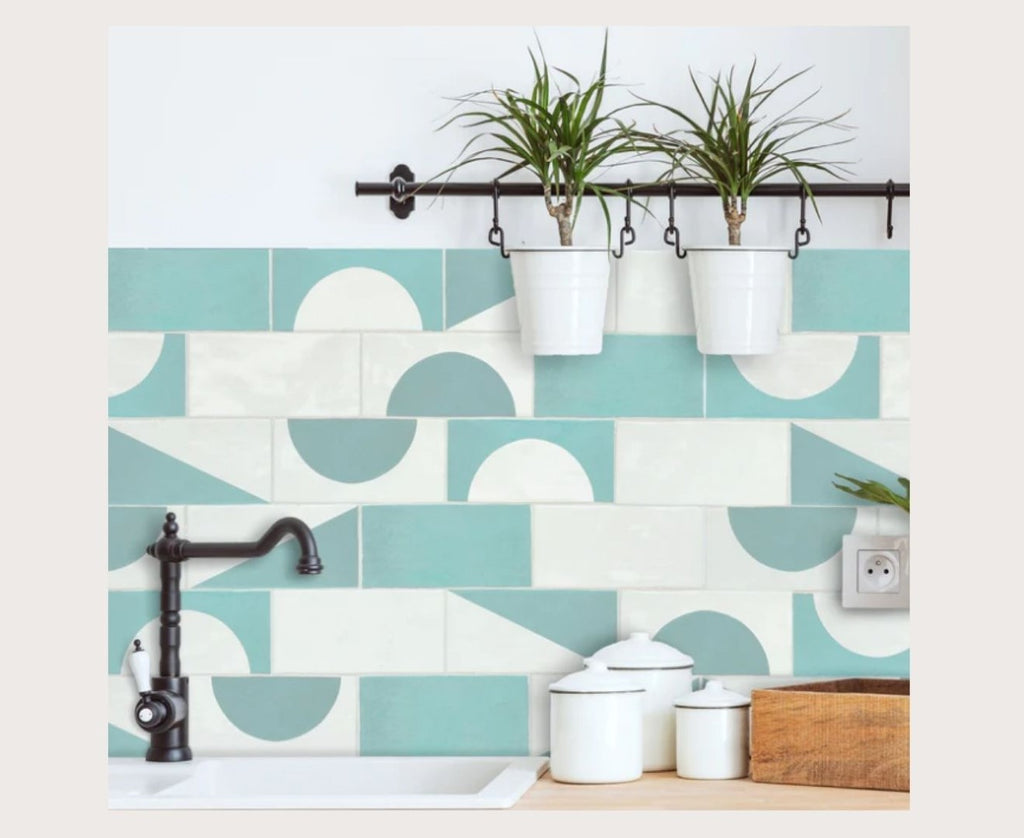A (very) short history of tiles
Decorum Tile Studio is proudly part of a long, illustrious and incredibly creative tradition.
We draw on millennia of tile makers before us and are constantly in awe of the imagination and resourcefulness of our predecessors!
Even the words themselves come from ancient history – “tile” comes from the Latin word “tegula” meaning “to cover”, whilst “ceramic” can be traced back to the Greek “kéramos” which meant “potter’s earth”.
When it comes to decorating a space, be it public or private, few things can rival the versatility of the humble tile. From ancient civilisations to modern-day interior design, these small pieces of glazed clay have managed to change human culture forever.
Ancient Origins
The roots of ceramic tiles can be traced back to ancient civilizations, where clay was readily available and used for various purposes. The first known use of ceramics dates as far back as 24,000 BCE in Eastern Europe, where crude clay figurines and pottery were crafted. As civilizations developed in Mesopotamia, Egypt, and the Indus Valley, the art of pottery-making evolved, leading to the creation of rudimentary clay tiles used for practical purposes such as roofing, flooring, and drainage systems.
Archeologists have found evidence of glazed bricks being used decoratively as far back as the 13th century BC in Iran. Furnaces have been found in ancient Pakistani settlements and tiles were used in the swimming pools of 6th century Sri Lankan Kings.

Small tiles were used on an industrial scale by the Roman Empire to create vivid mosaics of every day scenes (almost like paintings) that were used in everything from palaces to normal peoples’ homes. Such mosaics can be found from such far flung places as Rutland in England’s midlands, across to the huge collections found in Tunisia.
Persian & Islamic Influence: Tiles as an Art Form

Medieval and Renaissance Europe
Although smaller in scale that its Persian neighbour, Medieval Europe also developed its own thriving tile making culture, with tiles becoming an integral part of religious and secular structures. The Moors, who occupied parts of Spain and Portugal, brought with them the vibrant art of Islamic tilework. This quickly became a central part of Iberian culture and one that quickly spread to the South Americas as the Portuguese and Spaniards colonised huge parts of the continent.
Majolica, a tin-glazed earthenware, gained popularity in Italy, showcasing intricate hand-painted designs on ceramic tiles.
The Italian city of Florence became a hub for tile production, boasting workshops that produced stunning, hand-painted tiles for wealthy patrons and grand cathedrals. The use of decorative tiles spread throughout Europe, adorning palaces, churches, and public buildings with artistic and symbolic motifs.
Meanwhile Chinese artisans increasingly focused on ceramic vasework, decorative tablewear and incredible ceramic sculptures of mythical animals and deities.
Industrial Revolution: The Dawn of Mass Production
In Western European, tiles (and ceramics in general) remained one-off hand made luxuries until potters in the Dutch city of Delft began produce huge quantities of blue and white pottery in response to the growing demand for white Chinese porcelain. It is estimated that these artisans and their apprentices hand made 800 million tiles over about 200 years (roughly 1700-1900).

With the arrival of the Industrial Revolution in the 18th century, ceramic tile production underwent a transformative shift. Innovations in manufacturing processes allowed for mass production, making tiles more affordable and accessible to a broader range of consumers. As well as the Netherlands, England became a prominent tile manufacturer, exporting their wares across the globe and producing affordable tiles for all. Trade links to the United States opened up enormous new markets for anyone working in the tilemaking industry.
At the same time, there was an increasing awareness of disease and its link to hygiene and water safety which led to the creation of communal sewers for waste along with indoor bathrooms and toilets for upper and middle class families. Tiles became not only decorative, but a public health need and a necessity for any responsible home owner.
Art Nouveau & Art Deco: Embracing Modernism

The 20th century and beyond
New manufacturing techniques developed during the World War II, coupled with the post-war international building boom and the trend for ‘modernism’ led to the design theory that homes were to be “machines for living”. The 1941 publication Furniture and Decoration, Period and Modern, declared that “the kitchen and the bathroom should really be regarded as factories. They are purely utilitarian…bathrooms now are a nice, clear, clean white tile”.
As the century progressed, clinical white fell out of fashion and once again tiles could be as colourful and expressive as individual homeowners wanted. Salmon pink, avocado green and seemingly unstoppable waves of mustards took over the tiling world from the mid-1960s onward.
More recently, the metro tile (inspired by the tiles originally used in the Paris metro system) took the interior design world by storm in the early 2010s. Replacing the previously ubiquitous square tile, the narrow oblong metro tile could be used in all manner of patterns to create highly original, colourful designs.
Metro tiles remain popular today but with stiff competition from emerging 21st century trends which include oversized marble slabs used as tiles, to a rediscovery of the humble terracotta tile.

























